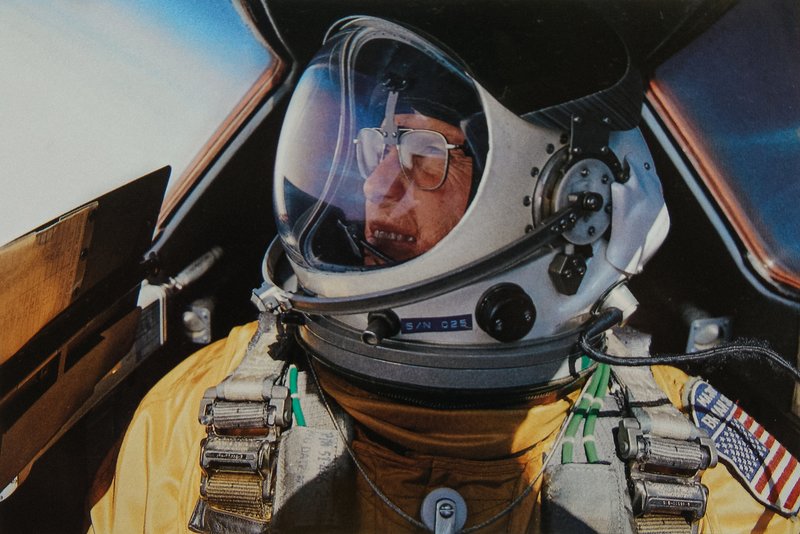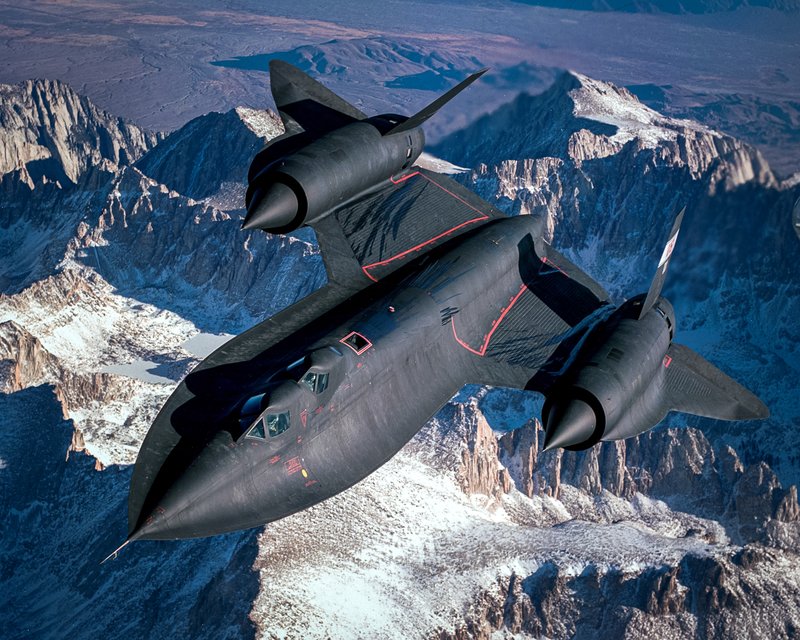
A front view of an SR-71 aircraft assigned to Detachment 4, 9th Strategic Reconnaissance Wing, as it prepares for takeoff. Department of Defense photo.
On April 15, 1986, an SR-71 Blackbird screamed over Libyan airspace at 2,125 mph. The world’s fastest spy plane had just crossed Muammar Gaddafi’s so-called “Line of Death,” a disputed boundary off the coast of Libya that the dictator threatened to enforce with military action.
The SR-71 climbed to 80,000 feet as its two-man crew scanned the earth below, assessing the damage inflicted by American airstrikes the previous night. Under Gaddafi, Libya had become a training ground for terrorist groups aligned with the regime’s anti-imperialist agenda, including one that the US government believed was responsible for a recent bombing at a West Berlin discotheque that killed and injured American service members.

A self-portrait of Brian Shul in full flight suit gear in the cockpit of the SR-71 Blackbird. US Air Force photo.
The airstrikes were meant to send a strong message to Gaddafi, but more intelligence was required to determine their effectiveness.
Air Force pilot Maj. Brian Shul and reconnaissance systems officer Maj. Walter Watson were on a mission to gather that intel. However, as Shul approached his final turn over the desert landscape, Watson alerted him that Libya’s air defenses — most likely SA-2 and SA-4 surface-to-air missiles — opened fire.
Shul pushed the limits of their highly advanced spy plane to outrun the missiles.

Brian Shul in the SR-71 Blackbird's cockpit. US Air Force photo.
“The plane was flying a mile every 1.6 seconds, well above our Mach 3.2 limit,” Shul wrote, recounting the story on a website dedicated to preserving the history of the SR-71. “I pulled the throttles to idle just south of Sicily, but we still overran the refueling tanker awaiting us over Gibraltar.”
It would be the fastest Shul would ever fly. But it wouldn’t be the last surface-to-air missiles the SR-71 Blackbird would outrun. In fact, during more than three decades of operational service, the SR-71 Blackbird would evade nearly 4,000 missiles.
Related: Nearly Killed in Vietnam, Brian Shul Triumphed to Become SR-71 Pilot
It Was Skunk Works’ Greatest Achievement

This close-up, head-on view of NASA's SR-71A Blackbird in flight shows the aircraft with an experimental test fixture mounted on the back of the airplane. Photo courtesy of NASA.
Lockheed Martin’s now legendary Skunk Works division has developed some of the US military’s most technically advanced aircraft, but the SR-71 is its most outstanding achievement. The division took its name from the famous comic strip Li’l Abner’s “Skonk Oil” factory, which ground dead skunks and worn-out shoes for an unrecognized purpose. Since 85% of Skunk Works projects remain classified, the name fits.
The operation began in 1943 to compete with the emergence of German jet fighters flying over Europe. The foremost mad scientist behind the project was engineering prodigy Clarence “Kelly” Johnson. He developed America’s first jet fighter with the P-80 Shooting Star, and he later produced the U-2 Dragon Lady spy plane to observe Soviet Union installations during the Cold War.
However, after U-2 pilot Francis Gary Powers was shot down during a 1960 mission, sparking an international incident that complicated US-Soviet relations during the Cold War, Skunk Works aimed to develop an even better aircraft.
According to Lockheed Martin, the first SR-71 Blackbird was designated as the A-12 and had one seat in the cockpit for the pilot. The A-12 had sheets of titanium alloy coated with heat-absorbing black paint, giving the Blackbird its nickname. The first flight was in April 1962.
A year later, a larger, two-seat A-12 set a new standard for aviation. The plane traveled at a staggering altitude of 78,000 feet and reached Mach 3 (2,000 mph), or three times the speed of sound. The test flight set world records, making the Blackbird the fastest and highest-flying manned aircraft. The new SR-71 Blackbird’s first flight was in 1964.
Related: How An SR-71 Blackbird Engineer Helped 3rd Graders With a School Project
Habu and the ‘Sled Drivers’

The crew of a NASA SR-71 Blackbird standing by the aircraft in their pressurized flight suits in 1991. Wikimedia Commons photo.
In the 1970s, four SR-71 Blackbirds were stationed at an airbase in Okinawa, Japan. As the Blackbirds flew around the island, Japanese citizens began pointing to the sky, shouting, “Habu, habu!” The sightings of the Blackbirds reminded them of the indigenous black snake found on Okinawa. As the legend grew, the pilots and aircrew associated with the program referred to themselves as “Habus.”
But that wasn’t their only nickname. Col. Rich Graham, an Air Force aviator who spent 15 years working with SR-71 Blackbirds, said most aviation enthusiasts know the pilots as “Sled Drivers.” The name was the result of a friendly rivalry between U-2 and Blackbird aviators.
“The U-2 pilots didn’t like calling the SR-71 by its proper nickname, so they came up with a derogatory name of their own, calling it the ‘Sled,’” Graham wrote in The Complete Book of the SR-71 Blackbird. “Being called a sled driver at the Officer’s Club bar usually brought on some disparaging remarks about the U-2!”

The SR-71B Blackbird, flown by Dryden Flight Research Center as NASA 831, slices across the snow-covered southern Sierra Nevada Mountains of California after being refueled by an Air Force tanker during a 1994 flight. The SR-71B was the trainer version of the SR-71 with an extra cockpit, which allowed for an instructor to fly the plane. US Air Force photo.
Piloting an SR-71 is an exclusive club — only 93 Air Force pilots in history were selected as “sled drivers.” The pilots went through an extreme selection process, including qualifying for an astronaut-level physical exam, performing two evaluation flights in the T-38 fighter plane with an instructor, and interviewing with squadron commanders.
Once selected by the SR-71 cadre, the candidates endured a 10-month training program until finally becoming operational pilots.
The SR-71 Blackbird flew missions until the 1990s, including a short stint with NASA, before it was permanently deactivated. The famous space agency used them for high-speed and high-altitude aeronautical research. Since its retirement, the United States military has searched for a replacement. Lockheed Martin’s long-rumored rendition of the SR-72, known as “The Son of the Blackbird,” is theorized as its successor.
Related: The Navy’s Elite TOP GUN Flight School Started in a Parking Lot Trailer
Did the SR-72 Make a Cameo in Top Gun: Maverick?

Lockheed Martin’s Skunk Works team engineered the DarkStar by working closely with Paramount Movies in Top Gun: Maverick. Photo courtesy of Lockheed Martin/Twitter.
Although the SR-72’s existence is cloaked in secrecy, a fictional rendition received a cameo in the 2022 blockbuster film Top Gun: Maverick. In the movie, Pete “Maverick” Mitchell, played by Tom Cruise, reaches Mach 10 while flying in the experimental hypersonic aircraft known as the DarkStar.
According to an interview with Variety, the movie’s production designer, Jeremy Hindle, collaborated with Lockheed Martin’s Skunk Works to create an authentic yet imaginative plane in the SR-72’s vintage. Even though the scenes used movie magic like CGI, the DarkStar was built full-scale to give the film’s actors a sense of realism.
“We went through 47 versions before landing on the final design and, when completed, it was an enormous 70 feet long,” Hindle said in 2022. “The cockpit contained real instrumentation and a prototype flight stick that Skunk Works loaned us.”
The DarkStar looked so convincingly lifelike that, according to movie director Jerry Bruckheimer’s interview with Sandboxx, “a Chinese satellite turned and headed on a different route to photograph that plane.”
The DarkStar represents Skunk Works' futuristic vision of hypersonic aircraft. However, the actual capabilities of the SR-72 will remain top secret until they are declassified.
Read Next: ‘Top Gun: Maverick’ — Why You Need To See the Year’s Best Action Movie in Theaters

Matt Fratus is a history staff writer for Coffee or Die. He prides himself on uncovering the most fascinating tales of history by sharing them through any means of engaging storytelling. He writes for his micro-blog @LateNightHistory on Instagram, where he shares the story behind the image. He is also the host of the Late Night History podcast. When not writing about history, Matt enjoys volunteering for One More Wave and rooting for Boston sports teams.
BRCC and Bad Moon Print Press team up for an exclusive, limited-edition T-shirt design!
BRCC partners with Team Room Design for an exclusive T-shirt release!
Thirty Seconds Out has partnered with BRCC for an exclusive shirt design invoking the God of Winter.
Lucas O'Hara of Grizzly Forge has teamed up with BRCC for a badass, exclusive Shirt Club T-shirt design featuring his most popular knife and tiomahawk.
Coffee or Die sits down with one of the graphic designers behind Black Rifle Coffee's signature look and vibe.
Biden will award the Medal of Honor to a Vietnam War Army helicopter pilot who risked his life to save a reconnaissance team from almost certain death.
Ever wonder how much Jack Mandaville would f*ck sh*t up if he went back in time? The American Revolution didn't even see him coming.
A nearly 200-year-old West Point time capsule that at first appeared to yield little more than dust contains hidden treasure, the US Military Academy said.












